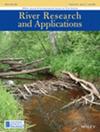俄亥俄州西南部溪流的土地覆盖、溪流排放和废水对基流沉积物和营养物浓度的影响
IF 1.9
4区 环境科学与生态学
Q4 ENVIRONMENTAL SCIENCES
引用次数: 0
摘要
营养物和悬浮沉积物浓度升高往往会对淡水环境造成负面影响。目前还缺乏直接比较以农业为主的流域和以城市为主的流域在基流条件下的悬浮沉积物和生物可利用营养物的研究。本研究的目的是确定俄亥俄州西南部溪流的土地覆盖、溪流排放和污水处理厂(WWTP)排放对营养物和沉积物浓度的影响。在 2016 年 11 月至 2017 年 11 月的 1 年时间里,从 8 条溪流中收集了每周基流样本。测量了总悬浮沉积物、硝酸盐和磷酸盐的浓度。结果表明,农业用地覆盖和污水处理厂增加了研究区域的硝酸盐和磷酸盐浓度。总悬浮沉积物和硝酸盐浓度随着排放量的增加而增加,而排放量对磷酸盐浓度的预测作用相对较弱。不同参数的季节性水质趋势各不相同,土地利用对季节性水质趋势也有独特的影响。研究结果表明,要改善研究区域的水质,应重点改善污水处理厂的污水处理和农田管理。本文章由计算机程序翻译,如有差异,请以英文原文为准。
Land cover, stream discharge, and wastewater effluent impacts on baseflow sediment and nutrient concentrations in SW Ohio streams
Elevated nutrient and suspended sediment concentrations often result in negative environmental impacts within freshwater environments. Studies that directly compare suspended sediment and bioavailable nutrients between predominantly agricultural and predominantly urban watersheds during baseflow conditions are largely lacking. The purpose of this study was to determine the impacts of land cover, stream discharge, and wastewater treatment plant (WWTP) discharge on nutrient and sediment concentrations, across a large land cover gradient in Southwest Ohio streams. Weekly baseflow samples were collected from eight streams over 1 year from November, 2016 through November, 2017. Total suspended sediment, nitrate, and phosphate concentrations were measured. Results indicate that agricultural land cover and WWTPs increase nitrate and phosphate concentrations in the study area. Total suspended sediment and nitrate concentrations increased with discharge, and discharge was a relatively weak predictor of phosphate concentrations. Seasonal water quality trends varied by parameter and land use also had unique impacts on seasonal water quality trends. Results suggest that to improve water quality in the study area, efforts should focus on improving WWTP effluent treatment and agricultural land management.
求助全文
通过发布文献求助,成功后即可免费获取论文全文。
去求助
来源期刊

River Research and Applications
环境科学-环境科学
CiteScore
4.60
自引率
9.10%
发文量
158
审稿时长
6 months
期刊介绍:
River Research and Applications , previously published as Regulated Rivers: Research and Management (1987-2001), is an international journal dedicated to the promotion of basic and applied scientific research on rivers. The journal publishes original scientific and technical papers on biological, ecological, geomorphological, hydrological, engineering and geographical aspects related to rivers in both the developed and developing world. Papers showing how basic studies and new science can be of use in applied problems associated with river management, regulation and restoration are encouraged as is interdisciplinary research concerned directly or indirectly with river management problems.
 求助内容:
求助内容: 应助结果提醒方式:
应助结果提醒方式:


